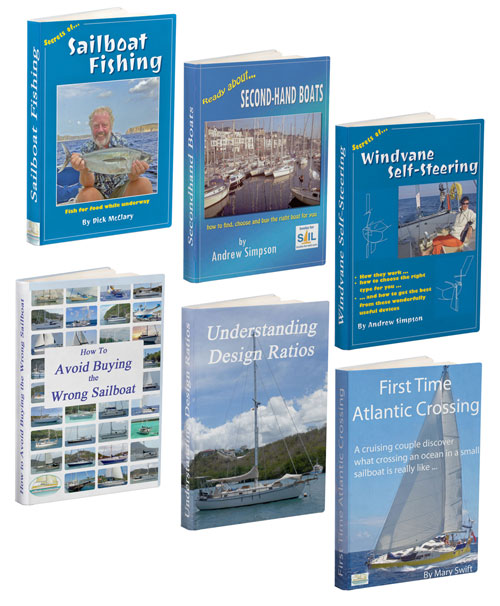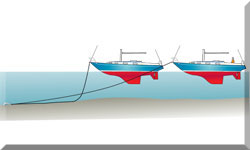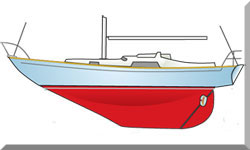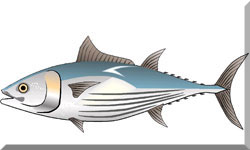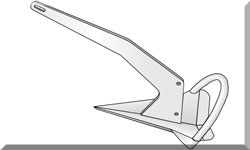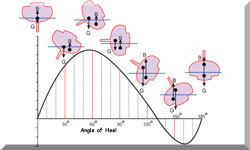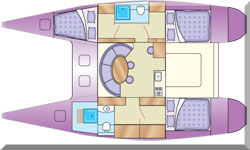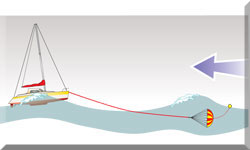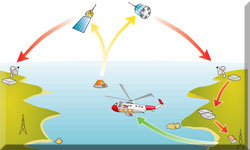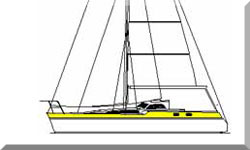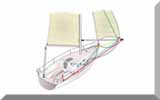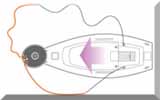The Ultimate Guide to Joining Anchor Chain
In a Nutshell...
Joining anchor chain can be a real head-scratcher, but the best way to go about it really depends on your boat and your set-up. If you're looking to connect two lengths of chain, a purpose-built chain connector is your best bet; it's designed to run clean through a windlass. For a chain-to-rope join, you’ll need a specific kind of splice that won’t get tangled. And don't even think about forgetting to attach the other end to the boat—it's a mistake you'll only make once!
Table of Contents
- What's the Story with Joining Anchor Chain?
- How Do You Join Two Lengths of Anchor Chain?
- How Do You Connect Rope to Your Anchor Chain?
- What's the Best Way to Attach the Anchor to the Chain?
- How Do You Attach a Snubber to the Anchor Chain?
- Why Must I Join the Anchor Chain to the Boat?
- How to Mark Your Anchor Chain & Rode
- Anchor & Chain Maintenance: What to Look For
- Essential Gear for a Complete Anchoring System
- Summing Up
- Frequently Asked Questions
What's the Story with Joining Anchor Chain?
As an experienced ocean sailor, I've learned a thing or two about what's important on a boat, and your anchoring system is right at the top of that list. A solid, single length of chain is always the ideal, but in the real world, that's not always practical. Maybe you want to add a bit more rode to tackle a deep anchorage without forking out for a whole new chain, or perhaps you'd rather save weight in the bows with a chain and rope combination. Whatever your reason, the key is to make sure your joins are up to the job. The last thing you want is your gear disappearing over the side when a squall hits.
How Do You Join Two Lengths of Anchor Chain?
This is a common one, especially for sailors looking to extend their existing rode. Most folks' first thought is to just slap a shackle on there, but here's the problem: a shackle that's strong enough for your chain will have a pin that's too big to pass through a link. Even if you manage to use two smaller shackles back-to-back, you'll have to mouse the pins with seizing wire. Trust me, that's not going to be fun if you're pulling it in by hand, and it's a disaster waiting to happen with a windlass.
The only real solution here is a proprietary connecting link from a reputable brand. These links are made specifically for this job and, when installed properly, are just as strong as the chain itself.
Here's a quick rundown of how to get it done right:
- Match the metals: This is a biggie. Don't, under any circumstances, use a stainless steel connector with a galvanised chain or vice versa. It'll cause galvanic corrosion, and your expensive gear will be toast in no time.
- Peen the rivets: This is the most critical step. Use a ball-peen hammer to properly peen the rivets over into the countersunk holes. If you're not confident you've done it right or you see any movement, cut it off and get a new one. A weak join will just jam in the windlass gypsy anyway.
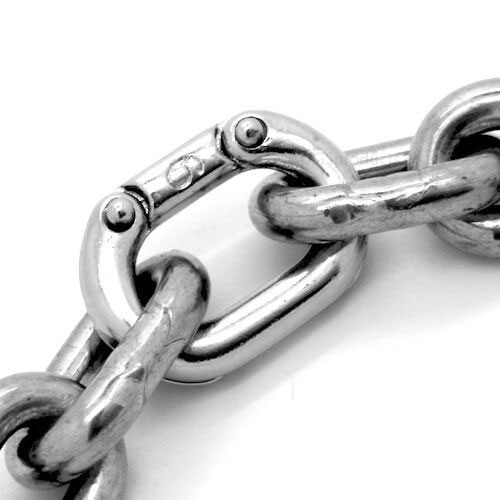 It's vital to properly peen over the rivets, as has been done here
It's vital to properly peen over the rivets, as has been done hereHow Do You Connect Rope to Your Anchor Chain?
Using a combination of chain and rope is a valid strategy for sailors who want to lighten the load in the bow. The challenge is making a join that's both super strong and can run smoothly through a windlass.
You could just splice a hard eye in a three-strand nylon rope and shackle it to the chain, but that's only good for manual hauling. It won't work with a windlass.
For a windlass-friendly connection, you'll need to use one of two specific splicing methods:
- A back splice to a single end link.
- An elongated splice threaded through several links of the chain.
Both of these create a join that flows right over the gypsy, so you won't have to worry about it jamming up. It takes a little practice to get the hang of splicing, but it's a skill every sailor should have.
What's the Best Way to Attach the Anchor to the Chain?
The final link in your ground tackle is where the business happens. A shackle is fine, provided it's properly moused with seizing wire, but here's a little sailing tip for you: anchors have a nasty habit of coming up the wrong way and getting stuck in the bow roller. It's almost guaranteed to happen just when you're tired and the weather's a bit frisky. You'll end up having to wrestle the anchor to get it stowed, which is no fun at all.
An anchor swivel is a great solution here. A good two-way swivel allows the anchor to spin and align itself correctly as it comes up, so it'll self-stow neatly in the stemhead fitting. This small bit of kit saves a lot of back strain and keeps your deck tidy.
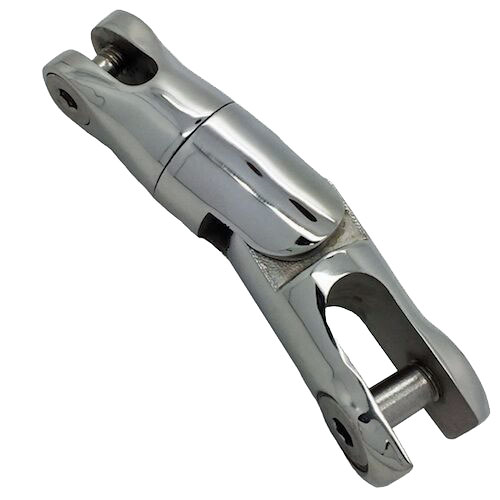 A 2-way anchor swivel works a treat!
A 2-way anchor swivel works a treat!How Do You Attach a Snubber to the Anchor Chain?
If you've got an all-chain rode, a snubber is an absolute must-have. It’s a stretchy piece of nylon rope that acts as a shock absorber, cushioning the boat and the gear from those nasty jolts.
You can get by with tying a rolling hitch on the chain, and a good one won't slip. But honestly, most cruisers will spend a few quid on a chain hook to avoid the faff of tying knots on a pitching deck. These hooks are a doddle to use and connect directly to a chain link.
A little piece of wisdom from years at sea: always keep a bit of tension on the snubber line as you deploy it to stop the hook from falling off. And when you want it to come off easily on retrieval? Well, that's when it'll refuse to budge!
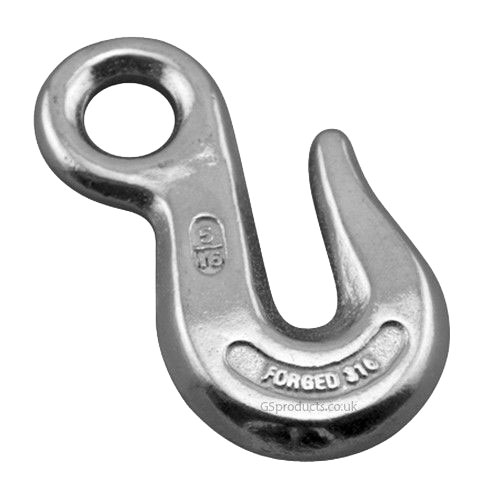 Make sure it's the right size for your chain!
Make sure it's the right size for your chain!Here's more about Snubbing the Anchor...
Why Must I Join the Anchor Chain to the Boat?
This might seem like a no-brainer, but you'd be surprised how many sailors have watched their entire anchoring system disappear over the bow because they forgot to secure the bitter end. Don't let it happen to you! The anchor chain must be attached to a strong point in your anchor locker.
The key is to do it in a way that you can let go in a hurry. If you find yourself dragging in a bad situation, you may need to slip the anchor and get out of there fast. A mechanical fixing is a bad idea here. A simple rope lanyard tied to a strong point is best, as you can cut or untie it quickly if you're in a pinch.
How to Mark Your Anchor Chain & Rode
When you're anchoring, knowing exactly how much chain you've paid out is critical. There's no getting around it—you need to know you've got enough scope down to hold the bottom, especially in crowded anchorages or during a blow. The easiest way to keep track is to mark your rode at regular intervals.
- Go Old School with Paint: The simplest way is to use a durable, waterproof paint, with a different colour every 10 metres.
- Plastic Markers: Special plastic markers that clip into the links are also an option. Just be careful; some can be a bit flimsy and might get caught in your windlass.
- Chain Counters: A chain counter can sound like a great idea, but in my experience, they can be pretty hit-and-miss and often need recalibrating. I'll always trust a clear, physical marking system over a digital one.
Anchor & Chain Maintenance: What to Look For
Looking after your gear is what being a good skipper is all about. A little bit of regular maintenance on your anchoring system will stop a small issue from becoming a big one.
- Give it a Good Once-Over: At least once a season, pull out your rode and give it a proper inspection. Look for any signs of rust, bent links, or wear, especially on those links near the anchor that take the most abuse.
- Wash it Down: Get into the habit of hosing down your chain with fresh water as it comes aboard to get rid of salt and sand. This is particularly important for galvanised chain, as salt can speed up corrosion. If you keep your boat in a marina, this won't be a problem. On a mooring and you don't have a watermaker, more so!
- Check the Joins: Take a close look at all your connections—shackles, swivels, and connectors—and make sure the pins are all secure and that nothing looks stressed or damaged.
Essential Gear for a Complete Anchoring System
Beyond the basics, there are a few other bits of gear that can make a massive difference to your anchoring experience.
- Snubbers & Bridles: If you’ve got an all-chain rode, a snubber is non-negotiable. For catamaran sailors, a bridle is the way to go, as it helps distribute the load evenly across the bows.
- Windlass Remote: A remote for your windlass is a real game-changer. It means you can manage the anchor from the foredeck without having to go back to the cockpit.
- Secondary Anchor: Always, always carry a second anchor, even if it's a smaller one. It's a lifesaver if you need a stern anchor to stop swinging or if your primary anchor drags or gets fouled.
Summing Up
When you're out on the water, your anchoring system is your lifeline. A strong, reliable join is a fundamental part of that. Understanding the right way to connect your gear, whether it's with a proprietary link, a windlass-friendly splice, or a simple shackle, is crucial for your safety and peace of mind. By getting these details right, you'll spend less time worrying about your gear and more time enjoying the sailing life.
When considering all the components of a safe and reliable anchoring system, it’s clear that joining the anchor chain is just one piece of a much larger puzzle. For a comprehensive guide to all aspects of anchoring, see our definitive pillar page, The Definitive Guide to Anchoring a Boat.
This article was written by Dick McClary, RYA Yachtmaster and author of the RYA publications 'Offshore Sailing' and 'Fishing Afloat', member of The Yachting Journalists Association (YJA), and erstwhile member of the Ocean Cruising Club (OCC).
Frequently Asked Questions
What kind of shackle should I use for anchor chain?
What kind of shackle should I use for anchor chain?
You should use a galvanised, high-tensile steel anchor shackle with a working load that matches or exceeds your chain.
What is a snubber, and why do I need one?
What is a snubber, and why do I need one?
A snubber is a short length of stretchy nylon rope attached to the anchor chain. It acts as a shock absorber, protecting your boat and gear from shock loads caused by waves and wind.
Can I join a stainless steel chain to a galvanised steel chain?
Can I join a stainless steel chain to a galvanised steel chain?
No. Joining different metals like this will cause galvanic corrosion, which will quickly weaken your chain at the join.
How often should I inspect my chain joins?
How often should I inspect my chain joins?
You should inspect all your joins and connections at least once a season. Look for signs of wear, corrosion, or damage, and replace anything that looks compromised.
Is it better to have all chain or a chain-rope combination?
Is it better to have all chain or a chain-rope combination?
It all depends on your boat and where you sail. All-chain gives you better holding power and chafe resistance, while a chain-rope mix reduces weight in the bow, which can improve sailing performance.
Recent Articles
-
Beneteau Oceanis 36CC: Specs, Ratios & Cruising Suitability
Nov 21, 25 06:26 PM
Detailed analysis of the Beneteau Oceanis 36CC centre cockpit sailboat. Includes design ratios, full specifications, and practical assessment of its suitability for experienced offshore and liveaboard… -
Mastering Offshore Seamanship: Heavy Weather & Safety Protocols
Nov 15, 25 05:00 PM
Expert guide to offshore safety and crew protocols. Master heavy weather tactics, self-steering redundancy, watchkeeping systems & essential personal safety gear. -
Transatlantic Passage: Reality, Setup & Lessons Learned
Nov 15, 25 04:41 PM
Offshore Yachtmaster details Alacazam's 3,000-mile transatlantic passage. Practical lessons on downwind rigging, windvane steering, & power generation systems.
